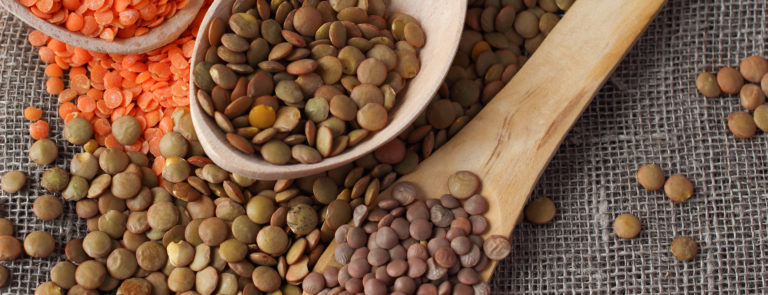Have a bag of lentils at the back of your kitchen cupboard, but aren’t sure what to do with them?
Whether you’re wondering about the benefits of eating lentils or you’re after some tasty inspiration on how to prepare them, we’ve put together an easy guide below to these brilliant pulses.
So, what exactly are lentils?
Put plainly, lentils are a type of legume – a variety of pulse that’s closely related to beans and grains
1. There are many different types of lentils, including:
- Green lentils – sometimes called French or Puy lentils, these have a nutty taste and are a flavourful addition to salads.
- Brown lentils – these are the most common type of lentil and they have a milder taste, making them a good base for lentil burgers.
- Red or yellow lentils – another common type, these include split peas. They tend to have a sweeter taste and are particularly common in Indian or Middle Eastern cooking.
- Black lentils – also called beluga lentils, these have a rich, earthy flavour and pair well with meat and mushrooms.
Lentils either come dried and require boiling or they are ready-cooked. Precooked lentils can be eaten cold or heated up in the microwave.
What are the benefits of eating lentils?
As well as being a cheap kitchen staple that will easily liven up your weekly meals, lentils have numerous amazing health benefits
2:
They’re a great source of fibre
Lentils are high in fibre, which is needed for digestion and to help maintain the health of your gut.
They’re low in fat
If you’re after a low-fat alternative to carbohydrates, lentils are a great pick. A cup of lentils (198g) typically contains less than 1g of fat.
They’re packed with protein
A cup of lentils, depending on the variety, typically holds just under 20g of protein. This is a little over a third of a man’s average recommended daily intake and just under half of a woman’s
3.
They contain a handful of vital nutrients
Lentils are an excellent source of certain essential vitamins and minerals which your body needs to function. These include vitamin B, iron, folate and potassium. Lentils also contain a lot of polyphenols – nutrients which are thought to have anti-inflammatory and antioxidant properties.
They count towards your five a day
As a legume, lentils do actually count as one of your five a day. Plus, you’ll only need to eat about three tablespoons of cooked lentils
4.
And the negatives?
While eating lots of lentils may seem like a no-brainer, there can be some downsides to these lovely legumes, especially if you don’t prepare them properly.
Like many beans, lentils contain a chemical called lectin. If they’re not cooked, they can be detrimental to your digestive system. That’s because lectin can attach itself to the lining of your intestines and become toxic, causing symptoms such as nausea or diarrhoea
5.
Five ways to cook lentils
Make them into a daal
Combine a cup of lentils with some fried vegetables, spices, vegetable stock and coconut milk to make a fragrant, Indian daal. Serve with naan.
Add them to a soup
Sick of making the same old soup? Mix it up by bulking out a vegetable broth with some lentils. Add your favourite vegetables and then tip in a tin of coconut milk or blended chickpeas for extra creaminess.
Create a lentil salad
For a protein-rich lunch or light summer dinner, try soaking cooked lentils in a dressing and then add them to a warm salad with roasted vegetables.
Turn them into lentil cakes
Forget potato cakes – lentil cakes are much more nutritious! To make them, boil some carrots or pumpkin and fry some onion and garlic. Combine these with a cup of cooked lentils, a cup of rolled oats and any spices or fresh herbs you like. Make into small patties and bake until golden brown.
Put some in a pie
If you’re looking for a meat-free alternative to put in a cottage pie, lentils are ideal. Add some cooked lentils and other veggies like carrots and peas to a tomato-based sauce, top with mashed potato and then bake.
Like the sound of adding these legumes into your diet? Check out our full range of dried and ready-cooked
lentils.
Shop Pulses
Last updated: 7 April 2020
Sources
1
https://www.cookinglight.com/eating-smart/nutrition-101/what-are-lentils-healthy
2
https://www.healthline.com/nutrition/lentils#nutrition
3
https://www.nutrition.org.uk/nutritionscience/nutrients-food-and-ingredients/protein.html?start=2
4
https://www.bhf.org.uk/informationsupport/heart-matters-magazine/nutrition/5-a-day/get-your-5-a-day
5
https://www.healthline.com/nutrition/lentils#antinutrients



